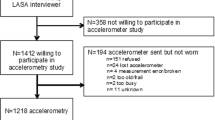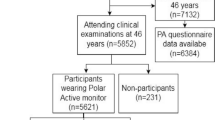Abstract
Background
Little attention has been paid to within-person daily associations among light physical activity (PA), moderate-to-vigorous physical activity (MVPA), and sedentary behavior (SB) with subsequent bodily pain and fatigue. Daily reports of pain and fatigue are less likely to be affected by recall bias and to conflate days of high and low pain/fatigue into one overall score.
Purpose
The purpose of this study was to examine daily within-person associations between pain, fatigue, and physical health and ascertain whether such associations are moderated by individual differences in these variables.
Methods
Participants were 63 community-living older adults (female n = 43, mean age = 70.98 years). Questionnaires measured typical levels of PA, SB, bodily pain, fatigue, and physical health. Subsequently, on a daily basis over a 1-week period, participants’ levels of light PA, MVPA, and SB were measured using accelerometers. Participants completed a questionnaire rating their pain and fatigue at the end of each day.
Results
Multilevel modeling revealed positive within-person associations between daily light PA, daily MVPA, and pain, as well as negative within-person associations between daily SB and pain. For individuals with higher typical levels of fatigue, there was a negative association between daily light PA, MVPA, and fatigue. For individuals with better levels of physical health, there was also a negative association between daily MVPA and fatigue. For those with higher typical levels of fatigue and better levels of physical health, there was a positive association between daily SB and fatigue. No such interaction effects were found between high levels of typical pain and PA or SB.
Conclusions
Our findings indicate that efforts to promote daily PA in older adults might be more effective for those who report high typical levels of fatigue and physical health, compared to those who report high levels of daily physical pain.
Similar content being viewed by others
References
United Nations. World population ageing 2015.; 2015. http://www.un.org/en/development/desa/population/publications/pdf/ageing/WPA2015_Report.pdf.
World Health Organization. 10 facts on ageing and health. http://www.who.int/features/factfiles/ageing/en/. Published 2016.
Bergh I, Steen G, Waern M, et al. Pain and its relation to cognitive function and depressive symptoms: a Swedish population study of 70-year-old men and women. J Pain Symptom Manag 2003;26(4):903–912. doi:10.1016/S0885-3924(03)00329-4.
Vestergaard S, Nayfield SG, Patel K V, et al. Fatigue in a representative population of older persons and its association with functional impairment, functional limitation, and disability. J Gerontol 2009;64A(1):76–82. doi:10.1093/gerona/gln017.
Sampaio RAC, Sewo Sampaio PY, Uchida MC, et al. Walking speed and balance performance are associated with short-form 8 bodily pain domain in Brazilian older female. J Clin Gerontol Geriatr 2015;6(3):89–94. doi:10.1016/j.jcgg.2015.02.005.
Williamson RJ, Purcell S, Sterne A, et al. The relationship of fatigue to mental and physical health in a community sample. Soc Psychiatry Psychiatr Epidemiol 2005;40(2):126–132. doi:10.1007/s00127-005-0858-5.
Vogel T, Brechat P-H., Leprêtre P-M., et al. Health benefits of physical activity in older patients: a review. Int J Clin Pract 2009;63(2):303–320. doi:10.1111/j.1742-1241.2008.01957.x.
World Health Organization. Global strategy on diet, physical activity and health-physical activity and older adults. http://www.who.int/dietphysicalactivity/factsheet_olderadults/en/. Published 2016.
Loprinzi PD. Objectively measured light and moderate-to-vigorous physical activity is associated with lower depression levels among older US adults. Aging Ment Health 2013;17(7):801–805. doi:10.1080/13607863.2013.801066.
Owen N, Sparling PB, Healy GN, et al. Sedentary behavior: emerging evidence for a new health risk. Mayo Clin Proc 2010;85(12):1138–1141. doi:10.4065/mcp.2010.0444.
Sesso HD, Paffenbarger RS, Lee I-M. Physical activity and coronary heart disease in men: the Harvard Alumni Health Study. Circulation 2000;102(9):975–980. doi:10.1161/01.CIR.102.9.975.
Matthews CE, Chen KY, Freedson PS, et al. Amount of time spent in sedentary behaviors in the United States, 2003-2004. Am J Epidemiol 2008;167(7):875–881. doi:10.1093/aje/kwm390.
Stamatakis E, Davis M, Stathi A, Hamer M. Associations between multiple indicators of objectively-measured and self-reported sedentary behaviour and cardiometabolic risk in older adults. Prev Med (Baltim) 2012;54(1):82–87. doi:10.1016/j.ypmed.2011.10.009.
Cecchi F, Debolini P, Lova RM, et al. Epidemiology of back pain in a representative cohort of Italian persons 65 years of age and older: the InCHIANTI study. Spine (Phila Pa 1976) 2006;31(10):1149–1155. doi:10.1097/01.brs.0000216606.24142.e1.
Connelly P. Guidance on the management of pain in older people. Age Ageing 2013;42:i1-i57. doi:10.1093/ageing/afs200.
Balboa-Castillo T, León-Muñoz LM, Graciani A, Rodríguez-Artalejo F, Guallar-Castillón P. Longitudinal association of physical activity and sedentary behavior during leisure time with health-related quality of life in community-dwelling older adults. Health Qual Life Outcomes 2011;9(1):47. doi:10.1186/1477-7525-9-47.
Ho A, Ashe MC, DeLongis A, Graf P, Khan KM, Hoppmann CA. Gender differences in pain-physical activity linkages among older adults: lessons learned from daily life approaches. Pain Res Manag 2016:9. doi:10.1155/2016/1931590.
Brown ST, Kirkpatrick MK, Swanson MS, McKenzie IL. Pain experience of the elderly. Pain Manag Nurs 2011;12(4):190–196. doi:10.1016/j.pmn.2010.05.004.
Reyes-Gibby CC, Aday L, Cleeland C. Impact of pain on self-rated health in the community-dwelling older adults. Pain 2002;95(1):75–82. doi:10.1016/S0304-3959(01)00375-X.
Rezende LFM de, Rodrigues Lopes M, Rey-López JP, Matsudo VKR, Luiz O do C. Sedentary behavior and health outcomes: an overview of systematic reviews. Lucia A, ed. PLoS One. 2014;9(8):e105620. doi:10.1371/journal.pone.0105620.
Haider S, Luger E, Kapan A, et al. Associations between daily physical activity, handgrip strength, muscle mass, physical performance and quality of life in prefrail and frail community-dwelling older adults. Qual Life Res 2016;25(12):3129–3138. doi:10.1007/s11136-016-1349-8.
Raudenbush SW, Bryk AS. Hierarchical Linear Models: Applications and Data Analysis Methods. Vol 1. Sage; 2002.
Curran PJ, Howard AL, Bainter SA, Lane ST, McGinley JS. The separation of between-person and within-person components of individual change over time: a latent curve model with structured residuals. J Consult Clin Psychol 2014;82(5):879–894. doi:10.1037/a0035297.
Gill TM, Desai MM, Gahbauer EA, Holford TR, Williams CS. Restricted activity among community-living older persons: incidence, precipitants, and health care utilization. Ann Intern Med. 2001;135(5):313. doi:10.7326/0003-4819-135-5-200109040-00007.
Egerton T, Chastin SFM, Stensvold D, Helbostad JL. Fatigue may contribute to reduced physical activity among older people: an observational study. Journals Gerontol Ser A Biol Sci Med Sci 2016;71(5):670–676. doi:10.1093/gerona/glv150.
Nicklas BJ, Beavers DP, Mihalko SL, Miller GD, Loeser RF, Messier SP. Relationship of objectively-measured habitual physical activity to chronic inflammation and fatigue in middle-aged and older adults. Journals Gerontol Ser A Biol Sci Med Sci 2016;71(11):1437–1443. doi:10.1093/gerona/glw131.
Moreh E, Jacobs JM, Stessman J. Fatigue, function, and mortality in older adults. J Gerontol A Biol Sci Med Sci 2010;65(8):887–895. doi:10.1093/gerona/glq064.
Ellingson LD, Kuffel AE, Vack NJ, Cook DB. Active and sedentary behaviors influence feelings of energy and fatigue in women. Med Sci Sports Exerc 2014;46(1):192–200. doi:10.1249/MSS.0b013e3182a036ab.
Wennberg P, Boraxbekk C-J, Wheeler M, et al. Acute effects of breaking up prolonged sitting on fatigue and cognition: a pilot study. BMJ Open. 2016;6(2):e009630. doi:10.1136/bmjopen-2015-009630.
Ravesloot C, Ward B, Hargrove T, et al. Why stay home? Temporal association of pain, fatigue and depression with being at home Disabil Health J 2016;9(2):218–225. doi:10.1016/j.dhjo.2015.10.010.
Murphy SL, Kratz AL, Williams DA, Geisser ME. The association between symptoms, pain coping strategies, and physical activity among people with symptomatic knee and hip osteoarthritis. Front Psychol. 2012;3(SEP).
Egerton T, Helbostad JL, Stensvold D, Chastin SFM. Fatigue alters the pattern of physical activity behavior in older adults: observational analysis of data from the generation 100 study. J Aging Phys Act 2016;24(4):633–641. doi:10.1123/japa.2015-0237.
McNeish DM, Stapleton LM. The effect of small sample size on two-level model estimates: a review and illustration. Educ Psychol Rev 2016;28(2):295–314. doi:10.1007/s10648-014-9287-x.
Maas CJM, Hox JJ. Sufficient sample sizes for multilevel modeling. Methodology 2005;1(3):86–92. doi:10.1027/1614-2241.1.3.86.
Hays RD, Sherbourne CD, Mazel RM. The RAND 36-item health survey 1.0. Health Econ 1993;2(3):217–227. doi:10.1002/hec.4730020305.
Smets EMA, Garssen B, Bonke B, De M, Haes JCJ. The multidimensional fatigue inventory (MFI) psychometric qualities of an instrument to assess fatigue. J Psychosom Res 1995;39(3 SRC):315–325. doi:10.1016/0022-3999(94)00125-o.
Miller J. Cross-generation accuracy. 2015. http://actigraphcorp.com/wp-content/uploads/2015/04/cross-generation-accuracy.pdf.
Choi L, Ward SC, Schnelle JF, Buchowski MS. Assessment of wear/nonwear time classification algorithms for triaxial accelerometer. Med Sci Sports Exerc 2012;44(10):2009–2016. doi:10.1249/mss.0b013e318258cb36.
Troiano RP, Berrigan D, Dodd KW, Mâsse LC, Tilert T, McDowell M. Physical activity in the United States measured by accelerometer. Med Sci Sports Exerc 2008;40(1):181–188. doi:10.1249/mss.0b013e31815a51b3.
Bélanger M, Townsend N, Foster C. Age-related differences in physical activity profiles of English adults. Prev Med (Baltim) 2011;52(3):247–249. doi:10.1016/j.ypmed.2011.02.008.
Padden DL, Connors RA, Agazio JG. Stress, coping, and well-being in military spouses during deployment separation. West J Nurs Res 2011;33(2):247–267. doi:10.1177/0193945910371319.
Washburn RA, McAuley E, Katula J, Mihalko SL, Boileau RA. The physical activity scale for the elderly (PASE): evidence for validity. J Clin Epidemiol 1999;52(7):643–651. doi:10.1016/S0895-4356(99)00049-9.
Washburn RA, Smith KW, Jette AM, Janney CA. The physical activity scale for the elderly (PASE): development and evaluation. J Clin Epidemiol 1993;46(2):153–162. doi:10.1016/0895-4356(93)90053-4.
Loland N. Reliability of the physical activity scale for the elderly (PASE). Eur J Sport Sci 2002;2(5):1–12. doi:10.1080/17461390200072504.
Gardiner PA, Clark BK, Healy GN, Eakin EG, Winkler EAH, Owen N. Measuring older adults’ sedentary time: reliability, validity, and responsiveness. Med Sci Sports Exerc 2011;43(11):2127–2133. doi:10.1249/MSS.0b013e31821b94f7.
Bolger N, Laurenceau J. Intensive Longitudinal Methods. New York: Guilford Press; 2013.
Hox J, Moerbeek M, Schoot R van de. Multilevel Analysis: Techniques and Applications. 2nd ed. New York: Routledge; 2010.
Gravetter F, Wallnau LB. Statistics for the Behavioral Sciences.Cengage Learning; 2016.
World Health Organization. Global Recommendations on Physical Activity for Health. 2011. http://apps.who.int/iris/bitstream/10665/44399/1/9789241599979_eng.pdf.
Focht B, Ewing V, Gauvin L, Rejeski W. The unique and transient impact of acute exercise on pain perception in older, overweight, or obese adults with knee osteoarthritis. Ann Behav Med 2002;24(3):201–210.
Mahieu MA, Ahn GE, Chmiel JS, et al. Fatigue, patient reported outcomes, and objective measurement of physical activity in systemic lupus erythematosus. Lupus 2016;25(11):1190–1199. doi:10.1177/0961203316631632.
Puetz TW, O’Connor PJ, Dishman RK. Effects of chronic exercise on feelings of energy and fatigue: a quantitative synthesis. Psychol Bull 2006;132(6):866–876. doi:10.1037/0033-2909.132.6.866.
Rongen-van Dartel SAA, Repping-Wuts H, Flendrie M, et al. Effect of aerobic exercise training on fatigue in rheumatoid arthritis: a meta-analysis. Arthritis Care Res (Hoboken) 2015;67(8):1054–1062. doi:10.1002/acr.22561.
Pilutti LA, Greenlee TA, Motl RW, Nickrent MS, Petruzzello SJ. Effects of exercise training on fatigue in multiple sclerosis. Psychosom Med 2013;75(6):575–580. doi:10.1097/PSY.0b013e31829b4525.
Manns PJ, Dunstan DW, Owen N, et al. Addressing the nonexercise part of the activity continuum: a more realistic and achievable approach to activity programming for adults with mobility disability? Phys Ther 2012;92(4):614–625. doi:10.2522/ptj.20110284.
Matthews CE, Moore SC, Sampson J, et al. Mortality benefits for replacing sitting time with different physical activities. Med Sci Sports Exerc 2015;47(9):1833–1840. doi:10.1249/MSS.0000000000000621.
Sliwinski MJ. Measurement-burst designs for social health research. Soc Personal Psychol Compass 2008;2(1):245–261. doi:10.1111/j.1751-9004.2007.00043.x.
Gando Y, Yamamoto K, Murakami H, et al. Longer time spent in light physical activity is associated with reduced arterial stiffness in older adults. Hypertension 2010;56(3):540–546. doi:10.1161/HYPERTENSIONAHA.110.156331.
Author information
Authors and Affiliations
Corresponding author
Ethics declarations
Ethical approval for this study was granted by the Ethical Review Committee at a UK university.
Authors’ Statement of Conflict of Interest and Adherence to Ethical Standards
Saengryeol Park, Cecilie Thøgersen-Ntoumani, Jet J. C. S. Veldhuijzen van Zanten, and Nikos Ntoumanis declare that they have no conflict of interest. All procedures, including the informed consent process, were conducted in accordance with the ethical standards of the responsible committee on human experimentation (institutional/national) and with the Helsinki Declaration of 1975, as revised in 2000.
Additional information
This research was supported by the National Institute for International Education of South Korea (Grant Number: 2011-43).
About this article
Cite this article
Park, S., Thøgersen-Ntoumani, C., Veldhuijzen van Zanten, J.J.C.S. et al. The Role of Physical Activity and Sedentary Behavior in Predicting Daily Pain and Fatigue in Older Adults: a Diary Study. ann. behav. med. (2017). https://doi.org/10.1007/s12160-017-9921-1
Published:
DOI: https://doi.org/10.1007/s12160-017-9921-1




